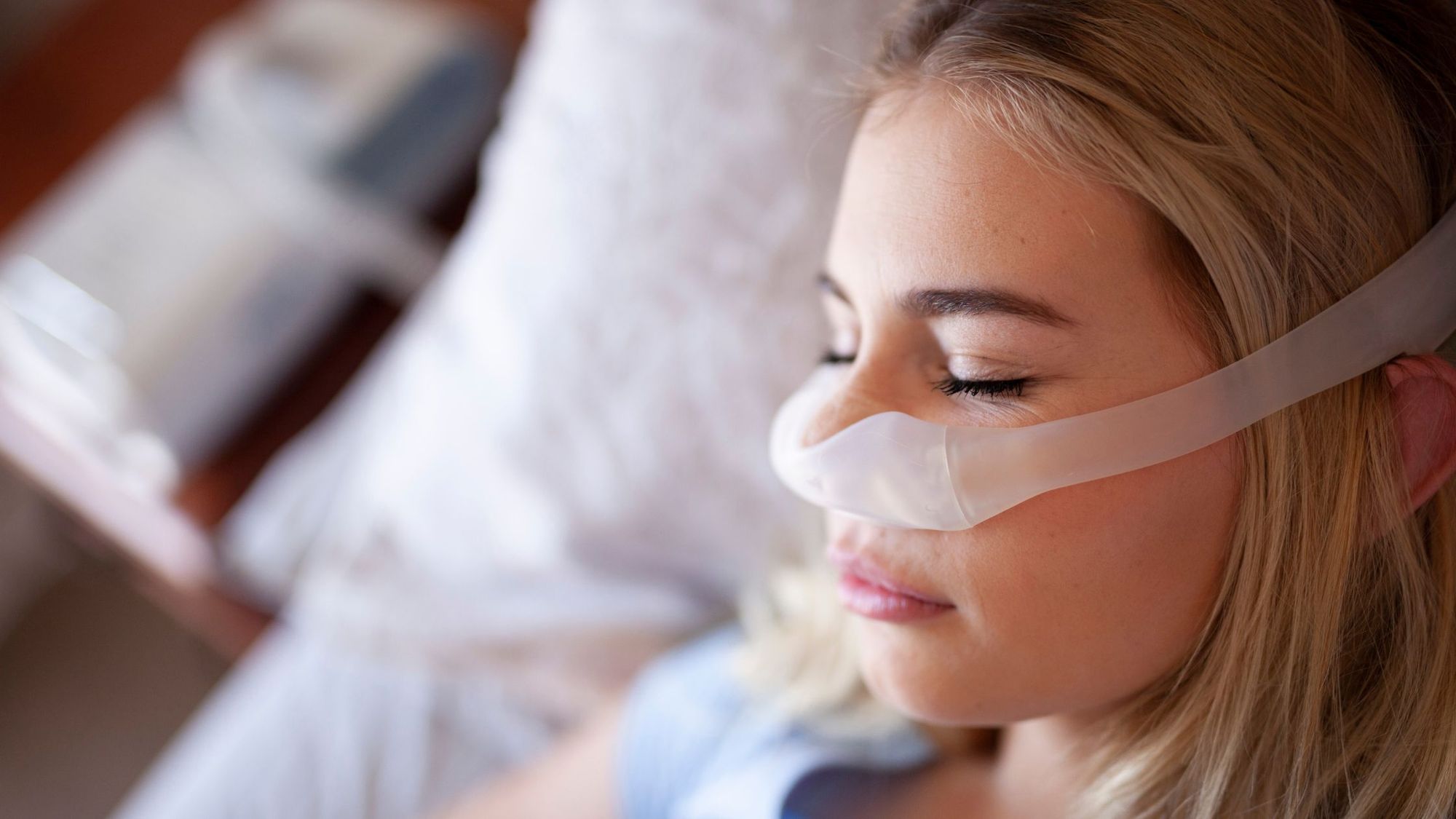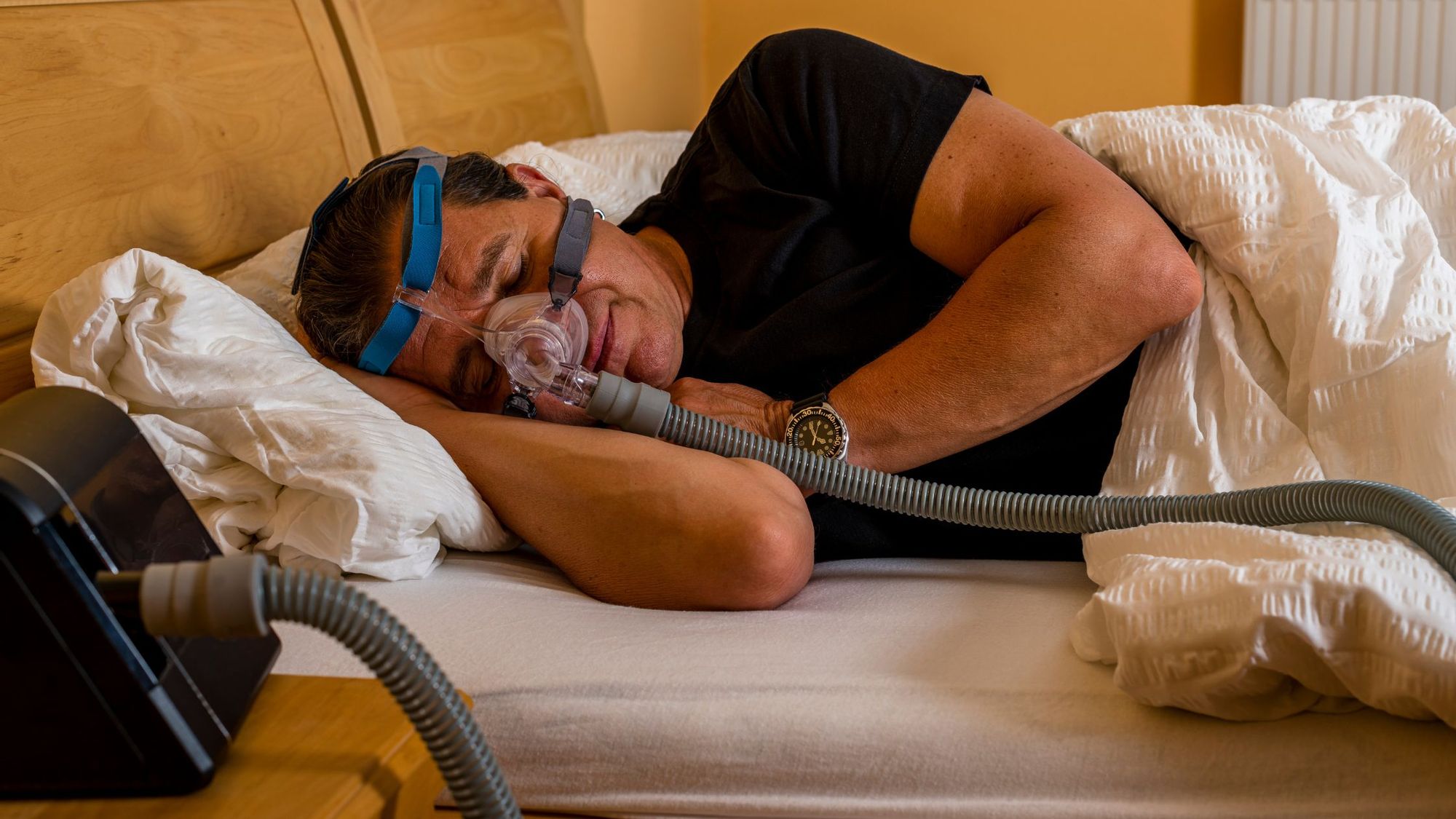
Sleep apnea is a sleep disorder that varies in intensity, and can be a very serious medical condition. Fortunately, there are sleep apnea treatment options that are effective.
Sleep apnea causes you to temporarily stop breathing while you’re asleep. This health condition is either caused by a blockage in the airway (which is a type of sleep apnea called ‘Obstructive Sleep Apnea), or it’s caused by an issue with the way your brain controls your breathing (Central Sleep Apnea).
If you have sleep apnea, your body will automatically wake you up periodically all throughout the night, so you can resume breathing. Waking up frequently due to sleep apnea disrupts your sleep cycle, and results in poor sleep quality.
Good quality sleep is crucial for your physical and mental health, as well as your overall well-being.

Why is Sleep Apnea Treatment so Vital for Your Health?
Any medical condition that disrupts your sleep (and any condition that impacts your breathing) should be immediately addressed, which is why sleep apnea treatment options are so important to discuss with your doctor.
However, before you can discuss sleep apnea treatment options, you first have to know whether or not you have sleep apnea, so you can get diagnosed.
Perhaps in the past, you ignored signs and symptoms of sleep apnea as they don’t seem that serious, especially if you’re not aware that you have this sleep disorder. These signs and symptoms to watch for include:
- Chronic fatigue or exhaustion
- Waking up frequently throughout the night, tossing and turning, or waking up to gasping sensations
- Dry mouth
- Waking up with headaches, dizziness, or a sore throat
- Snoring
- Mood changes such as irritability or anxiety
- Brain fog or trouble concentrating during the day
These are only some of the sleep apnea symptoms. Talk to your doctor to find out more signs of this disorder to watch for.
If you share a bed with a spouse, their input could be valuable. They might be noticing that you’re waking up gasping for air, choking, or snoring – and they might be able to help you figure out you have this condition.
If you sleep alone, try using a sleep app on your smartphone to record your sleep and find out how many times you woke up during your sleep. You could even record on a separate recorder to hear any choking or gasping sounds you make in your sleep.
A sleep study is often involved to diagnose sleep apnea. After diagnosis, sleep apnea treatment options will be discussed.
Furthermore, if you get diagnosed, you’ll either get diagnosed with Obstructive Sleep Apnea (OSA) or Central Sleep Apnea (CSA). Let’s review them below.

Obstructive Sleep Apnea
Individuals with Obstructive Sleep Apnea (OSA) temporarily stop breathing because their airway is blocked or constricted during sleep. The muscles in the back of the throat naturally relax during sleep for most people. However, if these muscles are larger, or more inflamed, they can restrict air flow excessively, making it difficult for a person to access enough oxygen.
Lack of oxygen prompts people with OSA to wake up throughout the night either partially, or fully, so the body can auto-correct the mistake and restore proper airflow. OSA can be worsened by additional components which increase the obstructions in your throat. For instance, people with swollen adenoids or tonsils could suffer from OSA.
Obstructive sleep apnea is the most common form of sleep apnea. Experts believe it affects approximately 10% – 30% of adults in the US, but the condition often goes undiagnosed since many of its symptoms like dry mouth and sore throat are easy to ignore. Let this be a lesson not to ignore symptoms that you can’t explain.
Central Sleep Apnea
Central sleep apnea is caused by problems with the functioning of your brain during sleep. Your brain is responsible for sending signals to all parts of your body through your central nervous system, telling your muscles and organs how to behave. If you have Central Sleep Apnea (CSA), the part of your brain responsible for autonomous functions, such as breathing, may not operate correctly.
In people with CSA, the brain stem could fail to recognize the carbon dioxide levels in the body during periods of rest, which causes shallow breathing. The brain may also fail to control the muscles responsible for breathing normally, which causes you to stop breathing for short periods of time.
While Central Sleep Apnea is less common than Obstructive Sleep Apnea, it can be just as dangerous, and a little more difficult to treat.
Notably, there’s also another form of sleep apnea known as Complex Sleep Apnea, which is what happens when someone with OSA begins to convert to CSA when receiving treatment for their obstructive sleep apnea.
Sleep Apnea Treatment Options
There are various sleep apnea treatment methods, which are designed to reduce the breathing disruptions you experience during sleep, and improve your sleep quality. Usually, the approach to treatment varies depending on whether you have Obstructive Sleep Apnea or Central Sleep Apnea, which doctors are able to determine, even though many of the symptoms overlap for the two types of sleep apnea.
Most sleep apnea treatment options fall into the categories of medical/surgical intervention, sleep apnea tools and devices, or lifestyle changes.
Medical/Surgical Treatments
For obstructive sleep apnea symptoms, treatments often involve tools used to open the airways. Positive Airway Pressure (PAP) therapy is the most common solution offered to patients.
Tools such as CPAP machines can pump pressurized air into an individual’s mouth and throat during the night, to prevent the muscles from collapsing. These machines require individuals to wear a mask which consistently streams the air down their throat and into their lungs. There are also other types of PAP device available, such as bi-level positive airway pressure, and auto-titrating positive airway pressure devices. These offer more variability in the level of air pressure delivered.
Some medical professionals will recommend specific mouthpieces to people with OSA, which hold the mouth or tongue in a certain position, and reduce snoring.
Surgery can also be an option to remove some of the excess tissue in the throat to expand the airway. This is often a common choice for people who have inflamed tonsils which might prevent them from breathing properly. Adenoids can also be removed, or the jaw may be reconstructed to enlarge the airway. In some cases, surgeons even use plastic rods in the soft palate to open the airway further.
Surgeons can also implant adaptive servo-ventilation devices into your body, which stimulate the nerves responsible for controlling breathing.
Lifestyle Changes as Sleep Apnea Treatment Options
Lifestyle treatments for sleep apnea symptoms are often recommended when the condition is mild. Some medical professionals will also recommend lifestyle changes alongside surgical or medical treatments, to improve the outcomes for the patient. You may be advised to:
Cardiovascular Exercise to Strengthen Lungs and Cardiovascular System
Exercise can improve the tone of the muscles throughout your body, which may lead to better control over your bodily movements and bodily functions. You can also use cardiovascular exercise such as swimming or an indoor cycling spin class to strengthen your lungs and cardiovascular system, which can be hampered by sleep apnea.
Use a CPAP Machine While You Sleep
Your doctor may recommend a sleep apnea device called a ‘’Continuous Positive Airway Pressure Machine’ (CPAP for short.) A CPAP machine is something you wear while you’re asleep if you have sleep apnea and this is the best treatment option decided by your doctor.
The CPAP machine delivers just enough air pressure to a mask you’ll be wearing while you’re sleeping, and it keeps your upper airway passages open, preventing snoring and sleep apnea.
It might feel a little weird to wear these machines at bedtime at first, but you’ll get used to it.
Lose Some Weight (If it’s Doctor-Recommended)
Losing weight (if you’re overweight) can reduce the number of breathing episodes you experience, and help to open your throat, to reduce sleep apnea symptoms.
Change Your Sleep Routine
Choosing to sleep on your side instead of on your back can be useful as an at-home sleep apnea treatment if you suffer from obstructive sleep apnea. You can also wear devices which keep your tongue in place through the night, or use body pillows to stop you from rolling onto your back.
Avoid Sedatives and Opioids.
Alcohol, xanax, anti-anxiety medications, sleeping pills and other sedatives can relax the muscles in the throat and interfere with your breathing. Some medications, such as opioids (Vidocin, for example) can even increase the risk because opioids are associated with several types of sleep-disordered breathing, including sleep apnea.
Does Sleep Apnea Run in Your Family? You Could Be At Risk
Sleep apnea is a condition that can run in families, so check your DNA test results to find out if you’re genetically at higher risk of sleep apnea, or at risk of other sleep disorders and health conditions.
Sleep apnea symptoms can be difficult to detect, but they’re something you should be watching out for in order to protect your health. If you notice any of the symptoms such as morning headaches, dry mouth, tossing and turning, waking up frequently, snoring, or the very important symptom of chronic fatigue and daytime sleepiness – see a doctor. You might get diagnosed with sleep apnea, and then you can get treatment.
There are links between sleep apnea and various serious health conditions, from depression and fatigue to heart attacks, and stroke.
This means that sleep apnea is not a health condition to ignore. It can be dangerous, and that’s why all of these sleep apnea treatment options are meant to intervene.
References:
- Up to Date: Clinical presentation and diagnosis of obstructive sleep apnea in adults
https://www.uptodate.com/contents/clinical-presentation-and-diagnosis-of-obstructive-sleep-apnea-in-adults - NCBI: Central Sleep Apnea
https://www.ncbi.nlm.nih.gov/pmc/articles/PMC2287191/ - Health.Cleveland: Could You Have Sleep Apnea — Without Knowing It?
https://health.clevelandclinic.org/sleep-apnea-its-waaaay-more-common-than-you-think/ - NCBI: Obstructive Sleep Apnea and Cardiovascular Disease: Role of the Metabolic Syndrome and Its Components
https://www.ncbi.nlm.nih.gov/pmc/articles/PMC2546461/ - NCBI: Central sleep apnea and Cheyne-Stokes respiration
https://pubmed.ncbi.nlm.nih.gov/18250216/#:~:text=Cheyne-Stokes respiration with central,waning pattern of tidal volume. - NCBI: Age-dependent influence of gender on symptoms of obstructive sleep apnea in adults
https://www.ncbi.nlm.nih.gov/pmc/articles/PMC6932841/ - NCBI: Chronic opioid use and central sleep apnea
https://pubmed.ncbi.nlm.nih.gov/25988636





